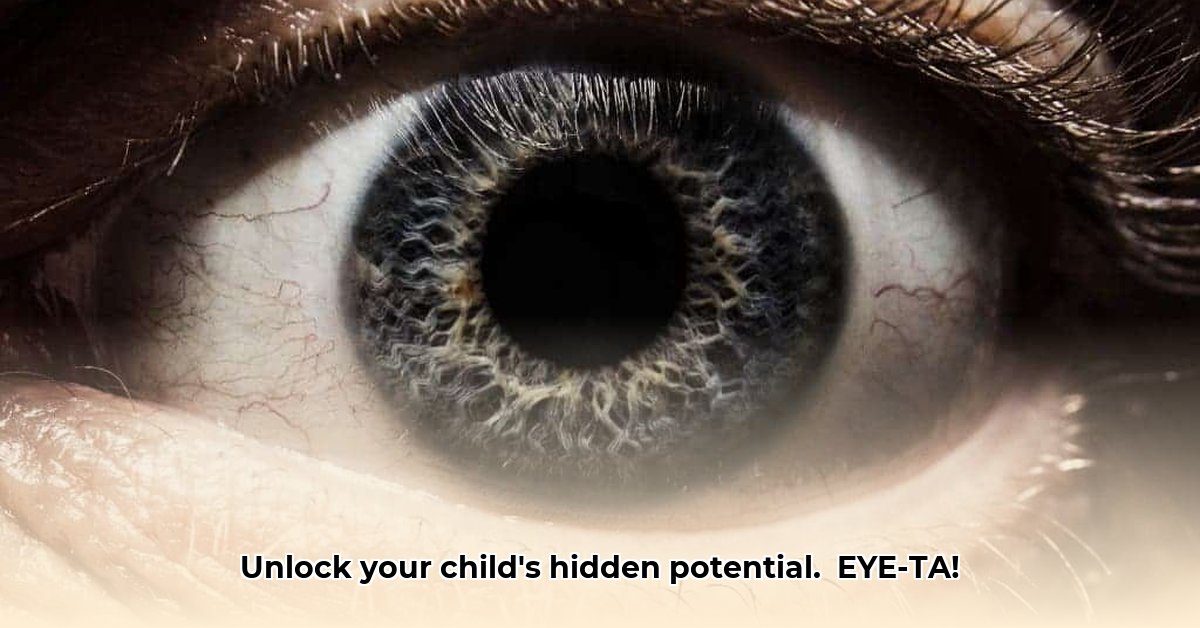Want to give your child the best possible start in life? The Early Years Evaluation (EYE) framework, incorporating both EYE-TA and EYE-DA, offers valuable insights. For more on effective parenting strategies, check out this helpful resource: Famous Parenting Tips. These tools provide a structured approach to understanding how young children learn and develop, enabling educators and parents to provide targeted support early on. This guide is designed for teachers, parents, and education stakeholders seeking to leverage the EYE framework to enhance kindergarten readiness and address potential learning challenges proactively. Let’s explore how the EYE can make a real difference in a child’s educational journey.
Diving Deep into the Early Years Evaluation (EYE)
The Early Years Evaluation (EYE) is a comprehensive framework designed to assess the skills and developmental needs of children aged 3-6 years as they prepare for kindergarten. It consists of two complementary components:
- EYE-DA (Direct Assessment): An individual, play-based assessment that measures a child’s developmental needs and pre-literacy skills through direct interaction and observation.
- EYE-TA (Teacher Assessment): A systematic framework used by teachers to structure informal classroom observations, enabling them to target instruction specific to each child’s unique learning needs.
What Exactly Is EYE-TA? Understanding Observational Assessments and Milestones
EYE-TA is a teacher-led observation method that provides insights into a child’s learning and development within a classroom setting. Unlike standardized tests, EYE-TA focuses on observing children during everyday activities to understand their strengths and areas for growth. It’s a process of actively seeing what a child can do and identifying areas where they might benefit from additional support.
Imagine a teacher observing children during circle time. They’re not just passively watching; they’re carefully noting how each child participates. Does the child follow instructions? Do they engage with the story? Do they interact positively with their peers? These observations contribute to a holistic understanding of the child’s cognitive, social-emotional, and physical development.
EYE-TA focuses on four key developmental domains:
- Cognitive Skills: Thinking, remembering, problem-solving, and attention.
- Language Development: Understanding and using language, communication skills, and pre-literacy abilities.
- Social-Emotional Development: Managing emotions, interacting with others, and developing social skills.
- Physical Development: Gross motor skills (running, jumping) and fine motor skills (drawing, writing).
How EYE-TA Works in the Classroom: A Detailed Look
EYE-TA is more than just casual observation; it’s a systematic and structured process. Teachers receive training to identify specific developmental milestones relevant to a child’s age. This ensures that observations are consistent and reliable across different classrooms and educators.
Teachers observe children in real-life learning situations, gathering information about their natural abilities and interactions. This naturalistic observation provides a more accurate picture of a child’s capabilities than a high-pressure testing environment.
The data collected through EYE-TA is used to inform instructional decisions. Teachers can tailor their lessons and activities to address individual needs and support each child’s growth. For example, if a teacher observes that a child struggles with fine motor skills, they might incorporate activities that involve using playdough, beads, or puzzles to strengthen those skills.
Benefits of EYE-TA for Educators and Parents: Enhancing Learning and Development
EYE-TA offers numerous benefits for educators and parents:
- Personalized Instruction: Teachers can design learning experiences that cater to each child’s unique learning style, pace, and needs, ensuring that every child feels supported and challenged appropriately.
- Early Identification of Learning Gaps: By identifying potential developmental delays or learning difficulties early on, teachers can provide timely interventions and support, preventing minor challenges from becoming significant problems.
- Improved Learning Outcomes: By providing targeted support and personalized instruction, EYE-TA helps children build a strong foundation for future learning and academic success.
- Enhanced Teacher-Parent Collaboration: EYE-TA fosters open communication and collaboration between teachers and parents. Sharing observations and insights allows for a unified approach to supporting the child’s development at home and in the classroom.
Challenges and Considerations in Implementing the EYE Framework
While the EYE framework offers significant advantages, it’s important to acknowledge potential challenges:
- Training and Resources: Effective implementation requires comprehensive training for teachers on observation techniques, data interpretation, and intervention strategies. Adequate resources and ongoing support are essential for successful implementation.
- Cultural Sensitivity: It’s crucial to ensure that observations are culturally sensitive and unbiased. Teachers need to be aware of cultural differences and how they may influence a child’s behavior and development.
- Ongoing Research and Evaluation: Continuous research and evaluation are necessary to validate the effectiveness of the EYE framework, refine its implementation, and ensure its continued relevance and impact.
EYE-TA and Parents: A Collaborative Approach to Child Development
Parents play a crucial role in supporting their child’s development. Here’s how EYE-TA can strengthen the parent-teacher partnership:
- Regular Communication: Regular communication between teachers and parents keeps everyone informed about the child’s progress, strengths, and areas for improvement.
- Home-Based Activities: Teachers can suggest activities that parents can do at home to reinforce learning and development. These activities can be tailored to the child’s specific needs and interests.
- Shared Goals: Parents and teachers share the common goal of helping the child thrive. By working together and sharing insights, they can create a supportive and enriching environment that promotes the child’s overall well-being.
The Future of EYE-TA: Continuous Improvement and Broader Application
The EYE framework is continuously evolving, with ongoing research aimed at refining its implementation, expanding its application, and maximizing its impact on children’s development. Researchers are exploring ways to enhance its cultural sensitivity, improve its accessibility, and integrate it with other early childhood programs.
By embracing frameworks like the EYE and continually refining them based on research and best practices, we can ensure that every child has the opportunity to reach their full potential. This requires a collaborative effort between parents, teachers, researchers, and policymakers.
Enhancing EYE-TA and EYE-DA Assessment Reliability: Best Practices
Key Takeaways:
- The EYE framework, including EYE-TA and EYE-DA, helps identify developmental strengths and weaknesses in young children.
- Early intervention is crucial for improving academic outcomes and long-term success.
- Ongoing research is needed to further validate the effectiveness of the EYE framework and refine its implementation.
- Collaboration among educators, parents, and researchers is essential for maximizing the impact of the EYE framework.
Understanding the Nuances of EYE-TA: Focusing on Observational Accuracy
EYE-TA is a valuable tool for educators seeking to gain a comprehensive understanding of a child’s developmental progress. However, like any assessment tool, it’s important to understand its limitations and strive for optimal reliability. Enhancing observational accuracy is paramount to ensuring that EYE-TA provides a valid and reliable picture of a child’s skills.
One of the key challenges in using EYE-TA effectively is ensuring inter-rater reliability, which refers to the consistency of observations made by different teachers. If different teachers observe the same child and come to significantly different conclusions, it raises concerns about the reliability of the assessment. More independent research is needed to fully validate the accuracy and inter-rater reliability of EYE-TA.
Practical Steps to Enhance EYE-TA Reliability: Data Collection and Standardization
Improving the reliability of EYE-TA requires a multifaceted approach that focuses on standardization, training, data validation, and collaboration:
- Standardize Assessment Procedures: Consistent administration is essential for reliable results. Provide teachers with clear guidelines, standardized scoring rubrics, and detailed protocols for conducting observations.
- Invest in Comprehensive Teacher Training: High-quality professional development is crucial. Teachers need extensive training not only on administering the assessment but also on interpreting the results accurately and implementing appropriate interventions.
- Implement Rigorous Data Validation: Conduct thorough research to validate the psychometric properties of EYE-TA. This includes assessing its consistency, accuracy, and fairness across diverse populations.
- Promote Collaboration and Communication: Foster open communication and collaboration among educators, researchers, and policymakers. Sharing best practices and lessons learned can help to continuously improve the effectiveness of EYE-TA.
- Establish a Feedback Loop: Create a system for teachers to provide ongoing feedback on the assessment’s strengths, weaknesses, and usability. This feedback can inform future improvements and ensure that EYE-TA remains relevant and effective.
Addressing Limitations and Challenges in Early Intervention Initiatives
While the EYE framework holds tremendous promise, it’s important to acknowledge and address potential limitations. One key area for improvement is the availability of independent validation studies. More research is needed to determine whether EYE-TA is equally effective for all students, particularly those from diverse backgrounds or those with specific learning needs.
Addressing these limitations and challenges is essential for ensuring that early intervention programs are effective, equitable, and impactful. By investing in research, training, and collaboration, we can maximize the potential of the EYE framework to support the development of all young children.
- Bulking Lunch Recipes that Make Muscle Gain Delicious - November 12, 2025
- Simple Asian Meal Prep Recipes to Spice Up Your Week - November 11, 2025
- Simple Asian Meal Prep Ideas For Healthy And Flavorful Weekday Meals - November 10, 2025










